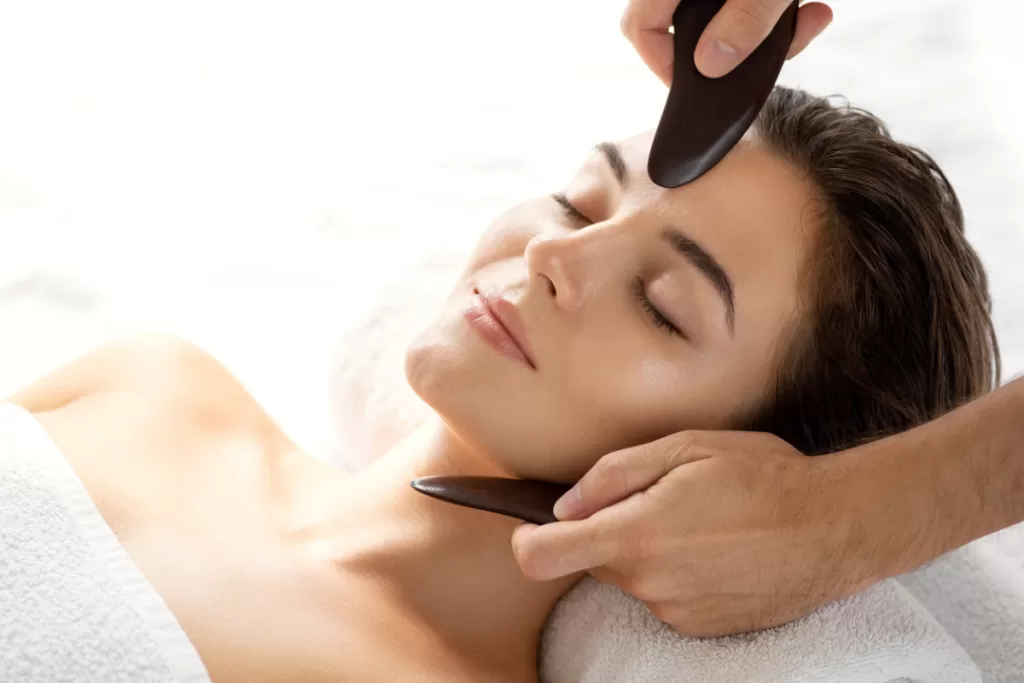
Have you paid attention to Gua Sha therapy? Do you know what the gua sha routine operation is? How to maximize the effect of gua sha? You will get the answer in this article.
How to Perform Gua Sha Routine Operation?
- Collect supplies:
Gua Sha Tools: Can be made from a variety of materials including jade, rose quartz, or buffalo horn.
Oil or lotion: Lubricates the skin and allows the tool to glide smoothly.
Clean cloth or paper towel: Use to wipe away excess oil and sweat.
- Prep your skin:
Cleanse your face: Start by cleansing your face to prevent dirt or makeup from being pushed into your pores in the process.
Use an oil or lotion: Apply a few drops of facial oil or lotion to your skin. This helps the tool glide easier.
- Technology:
Hold the tool: Hold the gua sha tool slightly firmly, making sure the tool is at a 15-45 degree angle to the skin.
Start Gua Sha: Start at the neck and shoulders, gua sha gently but firmly. Always scrape in one direction rather than back and forth. Strokes should be toward the edges of the face or body, not toward the center.
Pressure: Apply enough pressure to cause redness in the skin (called petechiae) but not to cause pain or discomfort. The pressure should be firm, but not so hard as to avoid bruising the skin.
Follow a pattern: You can follow a specific pattern, such as long strokes along the neck, short strokes on the face, and circular motions around the joints. Research different technologies and find the one that best suits your needs.
Be gentle with your movements: The skin on your face is delicate, so you should be especially gentle when gua sha.
- Key areas:
Neck: Start at the base of the neck and move up to the jawline.
Jawline and Cheeks: Stroke upward along the jawline and outward on the cheeks.
Forehead: Use horizontal strokes on the forehead, moving from the center toward the hairline.
Eyes: Be extremely gentle around the eyes. If desired, you can use smaller tools designed specifically for the eye area.
Body: If you are using Gua Sha on the body, focus on areas of tension or pain, always moving toward the extremities.
- Aftercare:
Cleansing: After gua sha, cleanse the skin to remove any remaining oil or debris.
Moisturize: Apply a soothing and hydrating moisturizer to your skin.
Hydrate: Drinking plenty of water helps flush out toxins and keep your skin hydrated.
Remember, gua sha should not feel painful. If you feel unwell, you may be stressed out. If you are unsure of your technique, consider consulting a professional practitioner for guidance.
Gua Sha Morning or Night? Which is Better?

Whether you choose to do gua sha routine in the morning or at night depends largely on your personal preference and schedule. There are no strict rules on the best time for gua sha, so you can choose the time that works best for your daily routine and lifestyle. The following are some precautions for gua sha routine in the morning and evening:
Gua Sha in the Morning:
- Awaken your skin: Gua sha in the morning can help stimulate blood flow, reduce puffiness and wake up your skin. It leaves your complexion fresh and radiant to start your day.
- Get ready for makeup: If you wear makeup, gua sha in the morning can help your skin care products absorb better and provide a smooth canvas for makeup.
- Boost energy: An energizing massage can help you feel more awake and energized, making it a great addition to your morning routine.
Gua Sha at Night:
- Relaxation and Stress Relief: Gua Sha routine at night can be a part of your pre-sleep relaxation routine, helping to relieve stress and tension built up throughout the day.
- Promotes better sleep: The calming effects of gua sha may help some people relax before bed, potentially improving sleep quality.
- Promote nighttime skin care: After gua sha, you can use nighttime skin care products and let them work effectively while your skin is still slightly stimulated by the massage.
Precautions:
- Consistency is key: The most important factor is consistency. Whether you choose morning or evening, try to stick to a routine. Regular gua sha sessions can provide cumulative benefits to your skin.
- Personal Preference: Some people find it more convenient to perform gua sha in the morning as part of their morning skincare routine, while others prefer to perform gua sha in the evening as a way to relax before bed.
- Avoid rushed sessions: No matter what time you choose, avoid rushing into a gua sha procedure. Take your time and massage with gentle, deliberate strokes.
Ultimately, the best time to do gua sha is when you can consistently incorporate it into your daily routine. Listen to your body and choose a time when you feel most comfortable and relaxed.
Recommended Gua Sha Routine Tools for Daily

When choosing a gua sha routine for daily use, you must choose one that is made of high-quality materials and feels comfortable on the hand and skin. Here are some recommended gua sha tools of different materials:
Jade is the traditional material for gua sha tools. It is known for its cooling properties and is believed to have healing powers. Look for genuine jade that is smooth and well-made.
Rose Quartz is a beautiful pink stone associated with love and healing. It is known for its calming and soothing properties. Rose quartz gua sha tools are a gentle option for daily use, especially if you have sensitive skin.
- Bianstone gua shatools:
Bianstone is a traditional Chinese medicine healing stone. It is believed to have natural healing properties. Bianstone gua sha tools often have a unique texture that enhances the massage experience.
- Buffalo horn gua shatool:
The Buffalo Horn Gua Sha Tool is smooth, lightweight and durable. They are often used in the traditional Gua Sha practice. If you choose this material, make sure the horn is ethically sourced.
- Stainless steel gua shatools:
Stainless steel gua sha tools are easy to clean and maintain. They are durable and provide a consistent massage experience. Some stainless steel tools have multiple edges and contours to fit different parts of the body.
- Combined tools:
Some gua sha tools have multiple shapes and edges on the same tool, allowing you to target different areas of the face and body more effectively.
When purchasing a gua sha tool, make sure it is genuine as there are many imitations on the market. Also, consider the size and shape of the tool. Some tools are specifically designed for facial gua sha, while others can be used on both the face and body. Choose tools that feel comfortable in your hand and have smooth edges to avoid irritating your skin.
Finally, it is important to maintain hygiene by cleaning your gua sha tool thoroughly after each use. The tool can be cleaned using warm soapy water and a soft brush. Regular cleaning also helps maintain the integrity and longevity of your tools.






